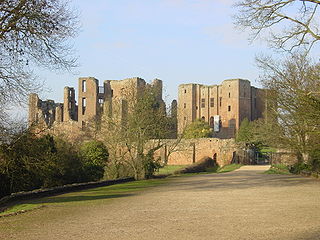
The Dictum of Kenilworth, issued on 31 October 1266, was a pronouncement designed to reconcile the rebels of the Second Barons' War with the royal government of England. After the baronial victory at the Battle of Lewes in 1264, Simon de Montfort took control of royal government, but at the Battle of Evesham the next year Montfort was killed, and King Henry III restored to power. A group of rebels held out in the stronghold of Kenilworth Castle, however, and their resistance proved difficult to crush.

The Battle of Lewes was one of two main battles of the conflict known as the Second Barons' War. It took place at Lewes in Sussex, on 14 May 1264. It marked the high point of the career of Simon de Montfort, 6th Earl of Leicester, and made him the "uncrowned King of England". Henry III left the safety of Lewes Castle and St. Pancras Priory to engage the Barons in battle and was initially successful, his son Prince Edward routing part of the baronial army with a cavalry charge. However Edward pursued his quarry off the battlefield and left Henry's men exposed. Henry was forced to launch an infantry attack up Offham Hill where he was defeated by the barons' men defending the hilltop. The royalists fled back to the castle and priory and the King was forced to sign the Mise of Lewes, ceding many of his powers to Montfort.

Evesham is a market town and parish in the Wychavon district of Worcestershire, in mid England with a population of 24,428, according to the 2011 census. It is located roughly equidistant between Worcester, Cheltenham and Stratford-upon-Avon. It lies within the Vale of Evesham, an area comprising the flood plain of the River Avon, which has been renowned for market gardening. The town centre, situated within a meander of the river, is regularly subject to flooding. The 2007 floods were the most severe in recorded history.

Evesham Abbey was founded by Saint Egwin at Evesham in Worcestershire, England between 700 and 710 AD following an alleged vision of the Virgin Mary by a swineherd by the name of Eof.
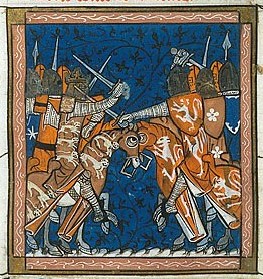
The Second Barons' War (1264–1267) was a civil war in England between the forces of a number of barons led by Simon de Montfort against the royalist forces of King Henry III, led initially by the king himself and later by his son, the future King Edward I. The war featured a series of massacres of Jews by Montfort's supporters including his sons Henry and Simon, in attacks aimed at seizing and destroying evidence of Baronial debts. After a rule of just over a year, Montfort was killed by forces loyal to the King in the Battle of Evesham.
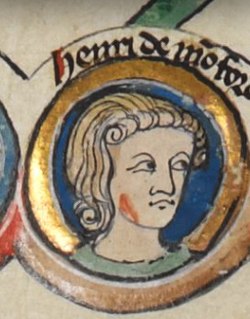
Sir Henry de Montfort was the son of Simon de Montfort, 6th Earl of Leicester, and with his father played an important role in the struggle of the barons against King Henry III. Henry's mother was Princess Eleanor of England, a daughter of King John, whose marriage to Simon further increased the foreign influence begun by the king, which was to result in great hostility by those very barons who later revolted against the king.

Guy de Montfort, Count of Nola was the son of Simon de Montfort, 6th Earl of Leicester and Eleanor of England.
Peter de Montfort of Beaudesert Castle was an English magnate, soldier and diplomat. He is the first person recorded as having presided over Parliament as a parlour or prolocutor, an office now known as Speaker of the House of Commons. He was one of those elected by the barons to represent them during the constitutional crisis with Henry III in 1258. He was later a leading supporter of Simon de Montfort, 6th Earl of Leicester, against the King. Both he and Simon de Montfort were slain at the Battle of Evesham on 4 August 1265.

Amaury de Montfort was the third son of parliamentary pioneer Simon de Montfort, 6th Earl of Leicester, and Eleanor of England, daughter of King John.
The Oxford Parliament (1258), also known as the Mad Parliament and the First English Parliament, assembled during the reign of Henry III of England. It was established by Simon de Montfort, 6th Earl of Leicester. The parlour or prolocutor (Speaker) was Peter de Montfort under the direction of Simon de Montfort. Simon de Montfort led the Parliament and the entire country of England for 18 months, from 1264 until his death at the Battle of Evesham.
Events from the 1260s in England.
The De Montfort School is a secondary school located in Evesham, Worcestershire, England. It is a mixed comprehensive community school serving 10- to 18-year-olds primarily from Evesham and its surrounding villages.

Simon VI de Montfort, known as Simon de Montfort the Younger, was the second son of Simon de Montfort, 6th Earl of Leicester and Eleanor of England.
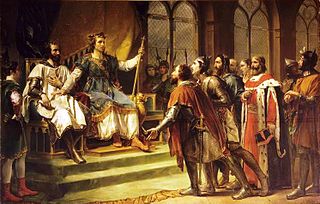
The Mise of Amiens[miz ɒv a.mjɛ̃] was a settlement given by King Louis IX of France on 23 January 1264 in the conflict between King Henry III of England and his rebellious barons, led by Simon de Montfort. Louis' one-sided decision for King Henry led directly to the hostilities of the Second Barons' War.
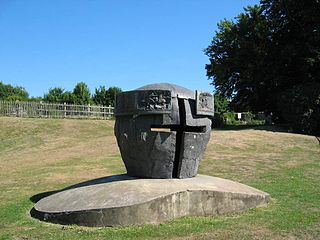
The Mise of Lewes was a settlement made on 14 May 1264 between King Henry III of England and his rebellious barons, led by Simon de Montfort. The settlement was made on the day of the Battle of Lewes, one of the two major battles of the Second Barons' War. The conflict between king and magnates was caused by dissatisfaction with the influence of foreigners at court and Henry's high level and new methods of taxation. In 1258 Henry was forced to accept the Provisions of Oxford, which essentially left the royal government in the hands of a council of magnates, but this document went through a long series of revocations and reinstatements. In 1263, as the country was on the brink of civil war, the two parties agreed to submit the matter to arbitration by the French king Louis IX. Louis was a firm believer in the royal prerogative, and decided clearly in favour of Henry. The outcome was unacceptable for the rebellious barons, and war between the two parties broke out almost immediately.
During the Second Barons' War, the Peace of Canterbury was an agreement reached between the baronial government led by Simon de Montfort on one hand, and Henry III of England and his son and heir Edward – the later King Edward I – on the other. The agreement was signed at Canterbury some time between 12 and 15 August 1264.
Edward Rudge was an English botanist and antiquary.
Sir Ralph Basset the 1st Baron Basset of Drayton was an English nobleman of the 13th century who fought in both the Anglo-French War and in the First War of Scottish Independence. He was the son of one of Simon de Montfort's baronial lords, Ralph Basset, and Margaret de Somery. In 1291, he was granted the governorship of Edinburgh Castle. He was created 1st Baron Basset of Drayton in 1295.














